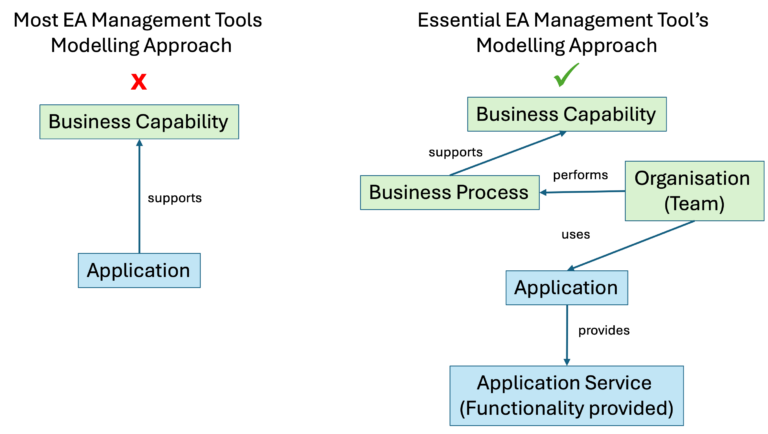In our blog “Why Qualitative Enterprise Architecture Data Really Matters”, posted earlier this week, we discussed a couple of case studies that demonstrated where relying on quantitative data caused real problems for a couple of organisations. The conclusion was that whilst quantitative data is clearly useful, a skilled enterprise architect understands the importance of marrying this with qualitative data to really understand the problem at hand and to deliver a resolution that achieves the goals of the project whilst also meeting the needs of the business.
How to do this though?
This is where a good enterprise architecture management tool can help. Looking at the case studies in question, in both examples the quantitative view provided to the management team highlighted that there were many duplicate processes and systems supporting one business area and suggested that rationalisation could provide significant savings. This quantitative view is one that is provided by many EA Management Tools, Essential included, however, the ability to drill down into the detail is crucial.
This is where Essential is different
Many EA Tools provide a simple mapping of applications directly to business capabilities. The rationale is that it provides a view that is loved by senior management and conveys very quickly where there is potential duplication. The downside is that, in reality, this quantitative view gives an indication only. Once you have the indication, you need to complete further analysis to see the real picture. Essential allows you to do this as, rather than mapping directly from an application to a business capability, it maps via process, organisation, and can also take into account the application functionality used in the process. This reflects how things are architected and related in real-life – an application supports a process performed by an organisation, that in turn support the delivery of a business capability .
Looking at the case studies discussed in the Why Qualitative Enterprise Architecture Data Really Matters blog, this more detailed modelling would have identified the issues that caused these projects to fail (quite spectacularly). Understanding the qualitative view, the detail behind the numbers, at an early stage is a key requirement in any project – however large or small.
Case Studies
In the first case study, where the recommendation was to implement standard processes and systems across all the production sites, the modelling in Essential would have identified that although all the companies followed a “production” process, these processes were, in fact, all different. This additional detail would have very quickly identified that these different processes had nuances that would not all be suited to the one-size fits all approach, and the hybrid approach eventually adopted could have been the initial recommendation, saving time, money, angst, and reputation. This is a classic example of why Essential has adopted its modelling approach of Business Capability to Process to Organisation to Application rather than the simplistic Business Capability to Application.
Similarly, in the second case study, the Australian State of Queensland’s Shared Services initiative aimed to provide common shared back-office services across the state. A pilot was conducted with a small agency, the Department of Housing, and then implementation commenced for the Queensland Health Authority, a large diverse agency. The ensuing fiasco, which culminated in costs exceeding a billion Australian dollars and the resignation of the Minister of Health, could have been avoided if a qualitative view of the enterprise architecture aspects had been taken from the outset. Such a view would have soon revealed the true mind-blowing complexity of the situation – non-standard processes covering many hundreds of different industrial agreements, allowances, calculation groups and rules. It would have been immediately apparent that a one-size system could not support this agency.

Most EA Tools vs Essential EA Tool modelling approach which facilitates qualitative analysis
A Practical Approach
Of course, we are not recommending that this level of modelling is the first step and is undertaken across the entire enterprise. A quantitative view showing the number of applications supporting each business capability is a great starting point. It highlights where there may be rationalisation opportunities. As mentioned, Essential can also provide this view quickly, but then the fidelity of the meta model, the ease of data capture and the supporting views allow you to enhance the data and see the real picture, the qualitative view.
The quantitative view identifies the areas of focus, additional analysis should then capture the detail required for the qualitative view:
- Understand and capture the number of organisations that perform processes for a specific business capability or business area – this covers the same teams in different geographies as often there are regulatory differences in processes or outputs at this level.
- Understand the processes performed by each of these teams/organisations – the actual process steps are not required at this stage, but a quick discussion with the business analyst or owner for each of the areas will reveal if the processes are indeed all the same or if there are variations.
- Understand if these variations are necessary. It may be that two different teams have ‘grown’ their processes organically, or to meet the needs of a different application being used. They could in fact both follow one standard process or there could be necessary differences due to regulatory or legal requirements that mean this is not possible.
- Understand what functionality, or services, are required across the set of processes.
- Capture which applications are currently being used in each process and, where known, the functionality used.
- Add costs to the Applications.
This will give a complete view of where rationalisation is possible, where it is not possible, what you already have in your estate that could meet the needs of the processes, the costs savings that could be made and an estimate of the effort required to remove applications.
All this is available in Essential, unlike most EA Tools we don’t stop at the high-level quantitative view. If you’re not using Essential, this leaves two options; do the additional analysis elsewhere, maybe even in spreadsheets and PowerPoints which will immediately be out of date; work off the quantitative view – a best guess with the associated risks rather than an informed decision.
As stated, skilled enterprise architects understand the importance of marrying qualitative data with quantitative data – as a skilled enterprise architect you want a tool that allows you to generate this data and truly supports you in your role. To discuss or try Essential contact us.
Useful links
Why Essential Models via Process
Why the Essential Meta Model Fidelity is Important
